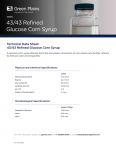Maltodextrin boosts quality of gluten-free bread: Study
Maltodextrins with a high dextrose equivalents measure were found to perform the best, offering alternatives for a rapidly growing industry dominated by products with of “low quality, exhibiting poor crumb and crust characteristics as well as poor mouth feel and flavour”, according to leading researchers in the field (Food Microbiology).
Use of maltodextrins with lower dextrose equivalents, however, detrimentally affected the quality of the finished bread, according to the researchers led by Leslaw Juszczak from the Agricultural University in Balicka, Poland.
The Polish researchers published their work in the Journal of Food Engineering.
The gluten-free market is growing rapidly. According to a recent report from Packaged Facts, the market has grown at an average annual rate of 28 per cent since 2004, when it was valued at $580m, to reach $1.56bn last year. Packaged Facts estimates that sales will be worth $2.6bn by 2012.
The market researcher said it expected to see a much wider range of gluten-free products on shelves by 2012, and said that this will be driven by companies reformulating existing products for gluten-free acceptability, as well as by releasing new ones.
Study details
Using maltodextrins (Cargill) with various dextrose equivalents (DE), including 3.6, 15.3, 18.0 and 21.8, the researchers formulated a variety of gluten-free bakery products. Measures of the stability and quality of showed that maltodextrins significantly affected starch gelatinisation, “by increasing pasting temperature and reducing viscosity of the obtained pastes”, they said.
The maltodextrin with the lowest DE detrimentally diminished the volume of the loaf and led to a deterioration of the bread quality. However, the highest DE improved bread volume and quality, and also effectively reduced the recrystallisation enthalpy of amylopectin, which has a direct impact on the staling of the bread.
“The application of maltodextrins with higher DE, especially 18.0 and 21.8, caused a significant growth of loaf volume and positively influenced hardening of crumb during storage,” wrote the researchers. “Significant increase of loaf volume probably could be attributed to a fact, that hydrolysates with higher dextrose equivalent were used as substrates for yeast fermentation.
“Because the maltodextrins with high dextrose equivalent positively influenced selected quality features of gluten-free bread, the studies should be extended on other starch hydrolysates (e.g. dry starch syrup),” they concluded.
Source: Journal of Food Engineering
Volume 96, Issue 2, Pages 258-265
“The effects of maltodextrins on gluten-free dough and quality of bread”
Authors: M. Witczak, J. Korus, R. Ziobro, L. Juszczak













